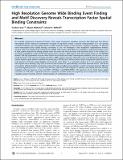High Resolution Genome Wide Binding Event Finding and Motif Discovery Reveals Transcription Factor Spatial Binding Constraints
Author(s)
Guo, Yuchun; Mahony, Shaun
DownloadGuo-2012-High resolution geno.pdf (2.379Mb)
PUBLISHER_CC
Publisher with Creative Commons License
Creative Commons Attribution
Terms of use
Metadata
Show full item recordAbstract
An essential component of genome function is the syntax of genomic regulatory elements that determine how diverse transcription factors interact to orchestrate a program of regulatory control. A precise characterization of in vivo spacing constraints between key transcription factors would reveal key aspects of this genomic regulatory language. To discover novel transcription factor spatial binding constraints in vivo, we developed a new integrative computational method, genome wide event finding and motif discovery (GEM). GEM resolves ChIP data into explanatory motifs and binding events at high spatial resolution by linking binding event discovery and motif discovery with positional priors in the context of a generative probabilistic model of ChIP data and genome sequence. GEM analysis of 63 transcription factors in 214 ENCODE human ChIP-Seq experiments recovers more known factor motifs than other contemporary methods, and discovers six new motifs for factors with unknown binding specificity. GEM's adaptive learning of binding-event read distributions allows it to further improve upon previous methods for processing ChIP-Seq and ChIP-exo data to yield unsurpassed spatial resolution and discovery of closely spaced binding events of the same factor. In a systematic analysis of in vivo sequence-specific transcription factor binding using GEM, we have found hundreds of spatial binding constraints between factors. GEM found 37 examples of factor binding constraints in mouse ES cells, including strong distance-specific constraints between Klf4 and other key regulatory factors. In human ENCODE data, GEM found 390 examples of spatially constrained pair-wise binding, including such novel pairs as c-Fos:c-Jun/USF1, CTCF/Egr1, and HNF4A/FOXA1. The discovery of new factor-factor spatial constraints in ChIP data is significant because it proposes testable models for regulatory factor interactions that will help elucidate genome function and the implementation of combinatorial control.
Date issued
2012-08Department
Massachusetts Institute of Technology. Computational and Systems Biology Program; Massachusetts Institute of Technology. Computer Science and Artificial Intelligence LaboratoryJournal
PLoS Computational Biology
Publisher
Public Library of Science
Citation
Guo, Yuchun, Shaun Mahony, and David K. Gifford. “High Resolution Genome Wide Binding Event Finding and Motif Discovery Reveals Transcription Factor Spatial Binding Constraints.” Ed. Stein Aerts. PLoS Computational Biology 8.8 (2012): e1002638.
Version: Final published version
ISSN
1553-734X
1553-7358